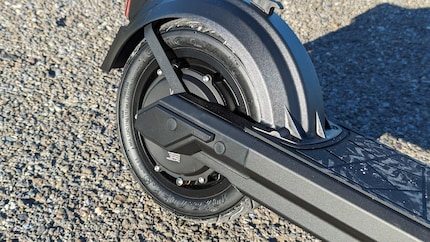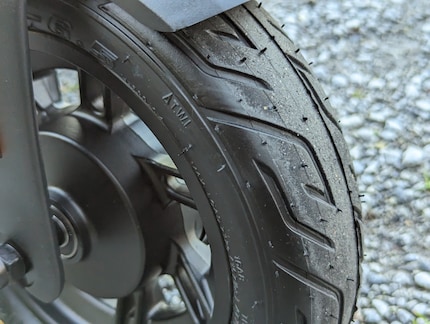
Product test
My wheelchair needs air! But how?
by Ramon Schneider

For a long time, I rode bikes with inner tubes. Today, I’d only buy an e-scooter with tubeless tyres. This is why you should also think carefully about your tyre choice before buying.
Performance, range and price – these factors are usually at the forefront when buying an e-scooter. Very few people care what kind of tyres are fitted, but there are actually three types to choose from. In my opinion, at least one of them definitely isn’t worth it.
My family uses two e-scooters with inner tube tyres. I’m actually really happy with the e-scooter, but when I bought it several years ago I ignored one detail: the type of tyres. Both two-wheelers have tyres with inner tubes, like you get in bicycles. It’s really simple with a bicycle, but e-scooters are different.
First of all, I painfully learnt how important tyre pressure is. If the pressure is a slightly too low on a bicycle you can still ride it without any major problems, whereas with an e-scooter the wear is immediate and increases massively. So you’re at a higher risk of a flat tyre. If the inner tube has lost air and you still want to ride home, the tyre will also soon be damaged.
That’s why, with an e-scooter, it’s very important to check the pressure every few weeks. Unfortunately, however, many e-scooters are delivered with an air pressure that is clearly too low. Before the first trip, you should definitely check the pressure. And don’t rely on feel – the tyres have to be much harder than you think.

Unfortunately the pressure level, which also depends on the weight of the rider, is often written in small print on the tyre or in the operating instructions. The recommended tyre pressure for many models is 3.5 bars or even higher. If you see psi (pounds per square inch) instead of the usual bar value, you can convert this online, for example via Google. 1 psi is 0.0689 bar.
Editorial colleague Ramon recently tested various air pumps. Since you should check the pressure of your e-scooter every month, it’s worth buying one.
With the small e-scooter tyres, even minor fluctuations have a big impact. But it’s not just too little air that can put the inner tube at high risk of damage. The electric scooters are very sensitive to kerbs, stones, broken glass, etc. Even with well-pumped wheels, I’ve had one or two defects a year.
It’s frustrating. Because depending on the brand, it’s not easy to find the right tubes. While the dimensions of bicycles are usually standardised, e-scooters are a bit of a wild jungle. Depending on the design, it’s also more annoying to change the tube than on a bicycle. Because you’ve hardly any room to navigate around the electric motors or disc brakes that are integrated into the bike.
If you can’t replace it yourself, you’re on the wrong track. Specialised repair shops for e-scooters are rare, and traditional bike mechanics usually don’t bother. If you’re unlucky and don’t live near a workshop such as the five Swiss branches of "Kiss my Wheels", you have to travel long distances. Plus, a tube replacement service costs between 80 to 100 francs.

The best alternative to tyres with inner tubes are tyres without inner tubes – called tubeless. Here, the tyre’s also inflated, but the air isn’t in a tube, but directly in the tyre – like in cars and motorcycles.
The huge advantage of tubeless tyres is their robust construction. They’re self-healing to a certain extent. In other words: small holes are sealed again. If you ride with slightly too little air in the tyre, this won’t immediately damage it.
The disadvantage of tubeless: if the tyre really is broken, replacing it is even more complicated than a tyre with an inner tube. Usually a professional has to look at it.
I’ve been enjoying testing a tubeless model, the Vmax VX2 Pro ST, for two months now and I haven’t had any problems. It’s comfortable, has a lot of power, a good range – and hardly loses any air in the tyres per month. Even though I ride over gravel paths several times a week, I haven’t had a flat tyre yet.
These kinds of wheels cushion impacts somewhat – but when correctly inflated, the absorbing effect of the tyres isn’t as great. If you want even more riding comfort, you’ll find models with proper suspension. I tested the Xiaomi 4 Ultra intensively. Thanks to the springs at the front and rear, you can also ride over cobblestones or gravel paths with total peace of mind.
There is another alternative to the inner tube, namely solid rubber tyres. They’re more stable and robust. You don’t need to worry about a flat tyre with these. Since solid rubber tyres only wear out after years, they’re practically maintenance-free.
However, there are some disadvantages with these too, as I discovered when testing the SoFlow So X. You can feel every uneven path throughout your body. This is less of a problem on well-built roads in the city, but it can be exhausting on concrete paths. Gravel paths are torture, they shake your entire body.
On the other hand, solid rubber makes special designs like the SoFlow So X possible: instead of spokes or a rim, the wheels simply have a hole and almost seem to float with the thin tyres. It looks really cool – but lacks comfort.
My conclusion: tubeless tyres are probably the right choice for most buyers. However, they’re primarily installed on scooters that cost 500 francs or more. This investment is worthwhile, as higher-quality electric scooters with larger batteries and a more powerful motor are used for a longer period of time too.
Header image: Lorenz Keller
Gadgets are my passion - whether you need them for the home office, for the household, for sport and pleasure or for the smart home. Or, of course, for the big hobby next to the family, namely fishing.
Practical solutions for everyday problems with technology, household hacks and much more.
Show all